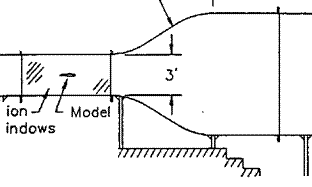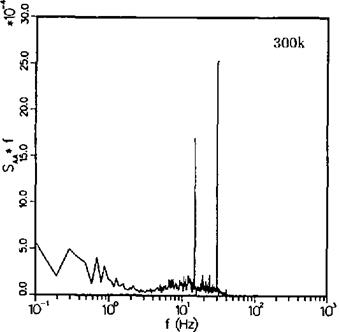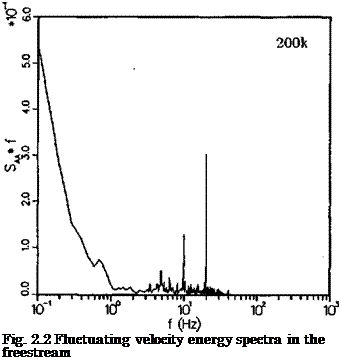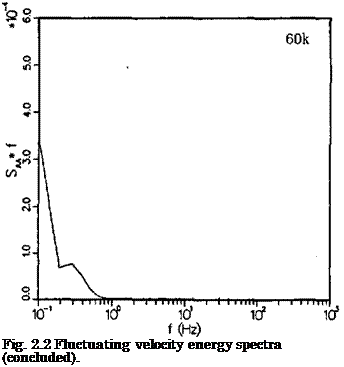Lift was measured directly using an electro-mechanical force balance, and the drag was found indirectly using the momentum method6. Rather than computing the drag based on just one vertical survey, the wake was surveyed and the drag computed at four spanwise locations and then averaged.
A sketch of the apparatus used to measure lift is shown in Fig. 2.7. The airfoil model was mounted horizontally in the tunnel between two | in clear plastic (Plexiglas) end plates (omitted for clarity) to isolate the model ends from the tunnel side-wall boundary layers and the support hardware. One side pivoted, and the other was free to move vertically on a precision ground shaft. Two linear ball bearings spaced 8 in apart provided essentially frictionless movement for a carriage which held the airfoil and angle of attack control hardware. Spherical bearings were used to minimize moments transmitted to each linear bearing. A force transducer coupled to the carriage through a pushrod sensed the lift (actually half the total model lift was transmitted to the transducer).
The force transducer in this study was a servo balance rather than a standard strain gauge or capacitance type transducer. As with a standard beam balance, the dead weight of the airfoil and the support structure are counterbalanced with weights. The remaining forces (the lift find residual imbalance) are balanced by the torque from a brushless DC torque motor mounted on the beam axis. Any angular displacement from a reference zero is sensed by an AC potentiometer, and the error signal is used to drive the torque motor until the error disappears. The torque required to do this is directly related to the lift. The current needed to generate the torque is a very linear analog of the torque, and therefore of the lift. ,
In practice several problems occur, the most difficult being to meet the requirement of low system friction. To achieve this, precision ball bearings were used throughout. The residual friction (as well as some magnetic hysteresis) was further reduced by adding a small amount of electrical dither to the torque motor. As built, the system was capable of measuring 7 lb (half of the lift) with stiction and hysteresis limited to 0.002 lb at the lowest Reynolds number. The overall system had an accuracy of ±0.25% of full scale or ± 0.002 lb, whichever is larger. The term full scale here refers to the maximum force experienced over a given run at constant Rn. This corresponds to ±0.0135 of Cj at Rn = 60k and ±0.0055 at 300k. Nine-point calibrations of the force balance were performed frequently to minimize the effects of drift.
The drag was measured using the momentum deficit method because the mechanical one is both difficult and expensive. In addition, drag obtained by mechanical means includes three-dimensional effects due to the side walls. These effects can be reduced by using a three-piece model with only the central panel connected to the force balance; however, the angle of attack of the two tips must be kept equal to that of the central portion and the gaps must be minimized. Althaus7 investigated the effect of a gap on the drag at low Rn and found that with a 0.5 mm (0.3%) gap and 250 mm (156%) span, the drag was increased 12% at an angle of attack of 9°.
To compute drag using the momentum method, a pitot tube was surveyed through the wake 1.25 chord lengths downstream of the trailing edge to find
the deficit. (Using a single pitot tube and moving it through the wake provided better spatial resolution of the wake than using a rake with multiple, fixed pitot tube locations.) Based on the application of the two-dimensional momentum and continuity equations to a control volume about the airfoil6, the drag force per unit span can be found as:
OO

 d = p
d = p
— OO
where the integral is performed perpendicular to the freestream, downstream of the airfoil. The freestream velocity is Voo, у is in the direction normal to the freestream, and и is the x-component of velocity at the downstream location.
This method of determining the drag is valid only if the wake survey is made in a region where the static pressure is equal to that in the freestream. Surveys on several airfoils indicated that static pressures in the wake were nearly equal to the freestream static pressure.
For pitot tube misalignments of less than 10°, the measured total pressure is essentially independent of flow angle. The drag calculation requires only the streamwise component of the velocity; thus, transverse velocity components at the survey location can decrease the measured drag. Drag values were found to remain constant as the survey location was moved upstream and downstream of the 1.25 chord location, indicating that it was sufficiently far from the trailing edge so that transverse velocity components were negligible.
Drag was calculated using the difference between the total pressure upstream of the airfoil and that in the wake. Equation (l) can be rewritten to give:
OO ‘
d = 2 J (у/Pdoo – aj°o) {y/Pdoo – VPdoO ~ APo)dy (2)
— OO
where Pdoo is the freestream dynamic pressure measured with a pitot tube which was 15 in upstream of the airfoil and 8 in below the centerline, and ДР0 is the difference between the total pressure in the freestream and the total pressure in the wake. This pressure difference is small and difficult to measure, requiring a sensitive transducer. A Baratron model 220B unit made by MKS Instruments, Inc. was used for this purpose with a full-scale range of 1 mm Hg and am accuracy of 0.15% of reading. It was factory calibrated against a standard traceable to the National Bureau of Standards.
Spanwise non-uniformity in the wake is well known7,8. Indeed, the drag variation can be more than 50% at the lower Reynolds numbers. As mentioned previously, four spanwise stations spaced uniformly over the central 1 ft of the airfoil were used, and they were averaged to provide a better measure of the airfoil performance.
A two-axis traversing mechanism provided position control for the downstream pitot tube (see Fig. 2.8). The important features and accuracies of this positioner are:
Spanwise motion: 24 in Vertical motion: 14 in Resolution:
less than 0.001 in, both directions Readout accuracy:
spanwise: 0.020 in vertical: 0.002 in Setability:
0.005 in, both directions
Each axis was instrumented with a precision DC potentiometer and was driven by a small, geared, DC motor. The carriage which held the pitot tube ran on precision bushings around centerless ground and polished rods, and the motors drove the carriage and potentiometers through a linkless steel and plastic chain. For stability, the entire carriage was mounted on a large aluminum “U” channel which was mounted to the bottom of the tunnel floor. The arm that carried the pitot tube projected into the tunnel through a slot cut in the floor, and both the arm and’slot were sealed to prevent air leakage into the tunnel.
Each motor and potentiometer together with associated electronics formed a position servo loop. The open-loop gain was quite high; however, the accuracy of the reading was independent of the gain, since it was read directly from the feedback potentiometers. Analog inputs to the positioner were provided by a computer with two digital-to-analog converters. Because accuracy was the design goal, there was no attempt to make the positioning particularly fast. This decision to ignore speed was soon regretted when it became apparent how long each run in the tunnel required. (Changes were made later that resulted in some improvement in the speed.)
Using this two-axis positioner, the surveys were made through the wake at four spanwise locations. Each survey consisted of between 20 and 80 pressure measurements (depending on the wake thickness) with points nominally spaced 0.08 in apart. A typical survey through the wake took two minutes, which effectively yielded a time-averaged drag value for each spanwise station.
Three pressure transducers (MKS model 220B) were used in this study. A 1 mm Hg full-scale unit measured the difference in total pressure between the wake and freestream as previously mentioned. Another 1 mm Hg unit measured the difference between the test section stagnation pressure and atmospheric pressure to allow an accurate calculation of the density in the test section. The third transducer had a 10 mm Hg full scale and was used to measure the dynamic pressure at the upstream pitot tube.
Due to the tunnel blockage from the lift apparatus installed in the test section, the velocity at the airfoil was greater than that upstream where the freestream dynamic pressure was measured. Since the upstream pitot-static probe did not sense the dynamic pressure at the airfoil, a calibration was performed to correct its reading. Using the continuity equation, it can be seen that the velocity ratio between the velocity at the airfoil and the velocity upstream of the blockage is simply the ratio of effective areas. Because the effective area of the apparatus is clearly a function of Reynolds number, a velocity ratio based on the Reynolds number was determined before every run. A velocity was found with the fixed upstream pitot-static probe and with the downstream pitot-static probe placed near the tunnel centerline with the airfoil installed but generating no lift. The ratio was determined at several speeds in the neighborhood of the actual run speed. A linear interpolation based on Reynolds number was then used during the run to determine the velocity at the airfoil based on the dynamic pressure of the upstream pitot-static probe. Throughout this work, the velocity difference between the upstream location and the airfoil was less than 6%.
During a run, which usually took about 1.7 hours, the tunnel velocity drifted slightly, depending on atmospheric conditions. To ensure ал accurate determination of the lift and drag coefficients, the measured lift and the APq were normalized by the instantaneous value of the freestream dynamic pressure. Thus, slow fluctuations in tunnel speed affected only the Reynolds number and not the determination of the aerodynamic coefficients.
Wind-tunnel corrections6 were applied to values of C; and Cd and were approximately 4% and 2%, respectively. Error estimates indicate that the accuracy of the measured Ci is ±1% and that of the Cd is ±4%. The angle of attack of the airfoil was controlled using a gear motor with a worm drive and a sector gear and was sensed using an angular transformer like that used in the force balance. The accuracy in determining a was ±0.02°.
All transducer voltages were recorded using a Scientific Solutions, Inc. 14-bit analog-to-digital converter interfaced to an IBM PC. The PC controlled the wake pitot tube position and the airfoil angle of attack. After manually setting the tunnel speed to achieve the desired Reynolds number, the data collection was completely automated and proceeded as follows: The first angle of attack was set, and the location of the wake was found. Next, the four wake surveys were performed. When they were complete, the angle of attack was increased and the process repeated. Usually, a polar at a given Reynolds number consisted of between 15 and 20 angles of attack from —3° to 15°. In all cases, this process continued into stall.
Drag was measured only for increasing angles of attack, so hysteresis was not examined. This was done for two reasons. First, the amount of run time would have doubled to 3.4 hours on average. Second, hysteresis is a sign of gross laminar separation—a high-drag condition. This investigation was directed towards the characteristics of low-drag airfoils in application to RC sailplanes; hence, high-drag conditions were of little interest. Furthermore, if the measured drag coefficient exceeded approximately 0.050 the run was stopped, again because there was no interest in high-drag conditions and also due to time constraints.
In addition to taking lift and drag data simultaneously, which was relatively slow, in many cases a second run was made in which just lift was measured, allowing the angle of attack to be incremented relatively rapidly. In this mode of operation, the angle of attack was increased up to a pre-set value and then decreased. Hysteresis loops present in the lift behavior were then sometimes observed. Approximately 140 data points were taken, and this process usually required 5 minutes—much less than the 3.4 hours that would have been required to obtain a complete drag polar at 1° increments in a. This lift data is included along with the polar data in Chapter 12. Increasing and decreasing angles of attack are denoted by solid-circle and open-square symbols, respectively. See Fig. 12.2 for example.




























